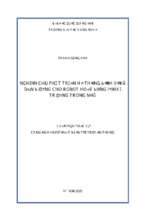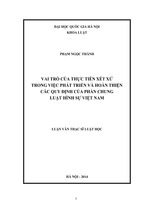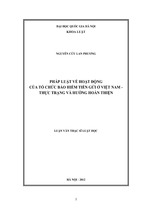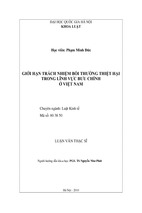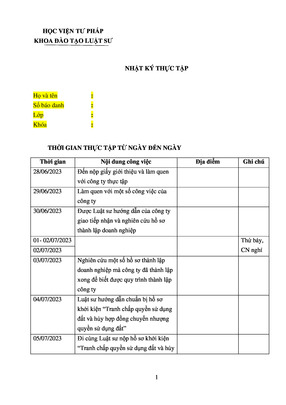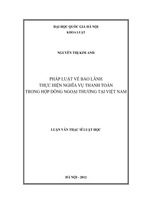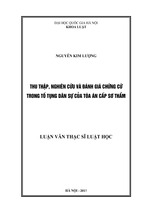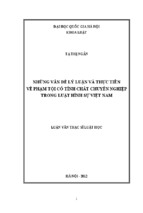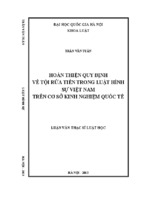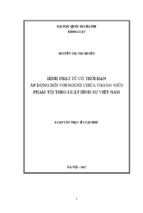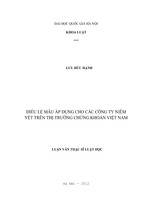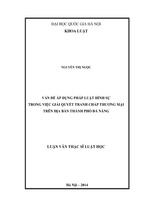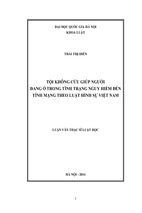HO CHI MINH CITY UNIVERSITY OF LAW
INTERNATIONAL LAW FACULTY
-----------***------------
PHẠM BÁ PHONG
STUDENT ID: 1853801012155
CLIMATE CHANGE RESPONSE: FROM
VIETNAM’S COMMITMENTS UNDER EVFTA AND
CPTPP TO ITS DOMESTIC IMPLEMENTATION
BACHELOR THESIS
School year: 2018 - 2022
Supervisor:
LL.M. Nguyen Thi Kim Cuc
Ho Chi Minh City - 2022
DECLARATION
I declare that this thesis is the result of my research, which is conducted
under the supervision of LL.M. Nguyen Thi Kim Cuc, ensures honesty, and
complies with rules and regarding quotation, the note of references. Therefore, I
hereby take full responsibility for this declaration.
LIST OF ABBREVIATIONS
Abbreviations
COP26
CPTPP
DAG
Contents
26th United Nations Climate Change
Conference of the Parties
Comprehensive
and
Progressive
Agreement for Trans-Pacific Partnership
Domestic advisory group
Decree No. 06/2022/ND-CP of the
Government on mitigation of green
Decree No. 06/2022/ND-CP
house
gas
(GHG)
emissions
and
protection of ozone layer dated 07
January 2022
EU
European Union
EVFTA
EU-Vietnam Free Trade Agreement
FTA
Free trade agreement
GHG
Greenhouse gas
ICAP
IPCC
The
International
Carbon
Action
Partnership
Intergovernmental Panel on Climate
Change
LEP
Law on Environmental Protection
MEA
Multilateral environmental agreements
MONRE
Montreal Protocol
Ministry of Natural Resources and
Environment
Montreal Protocol on Substances that
Deplete the Ozone Layer
NDC
Nationally determined contributions
TPP
Trans-Pacific Partnership Agreement
UN
UNFCCC
United Nations
United Nations Framework Convention
on Climate Change
TABLE OF CONTENTS
INTRODUCTION .................................................................................................... 1
1. Problem statement ............................................................................................. 1
2. Literature review ............................................................................................... 5
3. Purpose of the study .......................................................................................... 7
4. Objectives and Scope of the study ................................................................... 8
4.1. Objectives of the study.................................................................................. 8
4.2. Scope of the study ......................................................................................... 8
5. Research methodologies .................................................................................... 8
6. Scientific and practical values of the thesis ..................................................... 9
7. Thesis structure ................................................................................................. 9
CHAPTER 1: CLIMATE CHANGE RESPONSE COMMITMENTS UNDER
EVFTA AND CPTPP ............................................................................................. 10
1.1. Theoretical issues relating to climate change and climate change
response ................................................................................................................ 10
1.1.1. Definition of climate change .................................................................... 10
1.1.2. Causes and impacts of climate change..................................................... 12
1.1.3. General understanding of climate change response ................................. 14
1.2. Climate change response commitments under EVFTA and CPTPP ...... 16
1.2.1. The inclusion of climate change response commitments under free trade
agreements ......................................................................................................... 16
1.2.2. Climate change responses commitments under the EVFTA ................... 19
1.2.3. Climate change response commitments under the CPTPP ...................... 27
CONCLUSION OF CHAPTER 1 ......................................................................... 31
CHAPTER 2: CLIMATE CHANGE RESPONSE PROVISIONS UNDER
VIETNAMESE LAW AND RECOMMENDATIONS FOR VIETNAM.......... 32
2.1. Climate change response provisions under Vietnamese law .................... 32
2.1.1. General review of Vietnamese law and policy on climate change response
............................................................................................................................ 32
2.1.2. Evaluations ............................................................................................... 42
2.2. Recommendations for Vietnam ................................................................... 46
CONCLUSION OF CHAPTER 2 ......................................................................... 52
THESIS CONCLUSION ........................................................................................ 54
BIBLIOGRAPHY
INTRODUCTION
1. Problem statement
Climate change has been recognized as one of the biggest challenges of our
times threatening both regional and global security as well as diminishing the
significant development achievements of humanity at present and in the future 1.
According to United Nations (UN), the Earth is now about 1.1oC warmer than it
was in the late 1800s and the last decade (2011-2020) was the warmest on record2.
Following this, there exists various consequences of climate change such as intense
droughts, water scarcity, rising sea levels, flooding, melting polar ice and declining
biodiversity. Particularly, in 2021, Vietnam witnessed a relatively high average
temperature with 24.6oC, 0.7oC higher than usual. Moreover, Vietnam has suffered
from 12 storms and tropical depressions causing more than 40 heavy rains and
widespread flooding3. Besides, although climate change may be a result of natural
long-term shifts in temperatures and weather patterns, human activities has been the
main driver of climate change since the 1800s4, primarily due to burning fossil fuels
like coal, oil and gas.
Acknowledging climate change and its severe impacts to human lives,
countries has gravitated towards signing or participating in international agreements
on environmental protection, including climate change response. With respect to the
global frameworks on climate change response, Vietnam is a constituent member of
the United Nations Framework Convention on Climate Change (UNFCCC)5 which
1
For example, people living in small island nations and other developing countries are vulnerable to climate
impacts when, due to conditions such as sea-level rise and saltwater intrusion, whole communities have had
to relocate and suffer famine.
2
United Nations, “What is climate change?”, [https://www.un.org/en/climatechange/what-is-climate-change]
(accessed on 24 April 2022)
3
Phan Hau, “Climate change makes weather and natural disasters abnormal and irregular”,
[https://thanhnien.vn/bien-doi-khi-hau-khien-thoi-tiet-thien-tai-dien-bien-di-thuong-trai-quy-luatpost1451345.html] (accessed on 24 April 2022)
4
United Nations, supra note 2.
5
The United Nations Framework Convention on Climate Change (UNFCCC) opened for signature at the
“Rio Earth Summit” in 1992 entered into force on 21 March 1994. Further information available at:
UNFCCC, “What is the United Nations Framework Convention on Climate Change?”,
[https://unfccc.int/process-and-meetings/the-convention/what-is-the-united-nations-framework-conventionon-climate-change] (accessed on 20 may 2022)
1
was the first global agreement on climate change and possesses near-universal
membership with 197 Parties. Furthermore, within the UNFCCC framework,
Vietnam is also a member of two international agreements, namely the Kyoto
Protocol6 and the Paris Agreement7. Regarding Paris Agreement, at the end of the
26th United Nations Climate Change Conference of the Parties (COP26)8 hosted in
Glasgow on 31 October – 13 November 2021, the Paris Agreement target of
limiting global warming to 1.5 degrees Celsius was kept alive and the Paris
Agreement rulebook was completed9. Notably, at COP26, Vietnam delivered strong
commitments which include reaching net-zero carbon emission target by 2050,
stopping deforestation by 2030 and phasing out coal-fueled power generation by
204010.
In addition to participating in international agreements on climate change,
Vietnam, similar to other nations, has been striving to incorporate climate change
response provisions in regional trade agreements, particularly, the free trade
agreements (FTAs)11. In this context, Vietnam has become a constituent member of
two new-generation FTAs
12
, namely EU-Vietnam Free Trade Agreement
(EVFTA) 13 and Comprehensive and Progressive Agreement for Trans-Pacific
6
The Protocol was adopted on 11 December 1997 and it entered into force on 16 February 2005. Further
information
available
at:
UNFCCC,
“What
is
the
Kyoto
Protocol?”,[https://unfccc.int/kyoto_protocol](accessed on 12 June 2022)
7
The Paris Agreement was adopted by 196 Parties at COP 21 in Paris, on 12 December 2015 and entered
into force on 4 November 2016. Further information available at: UNFCCC, “The Paris Agreement”,
[https://unfccc.int/process-and-meetings/the-paris-agreement/the-paris-agreement] (accessed on 12 June
2022)
8
Conference of the Parties (COP) is a global climate summits and COP26 which took place in Glasgow
means 2021 was the 26th annual summit.
9
Further information available at: European Commission, “COP26: EU helps deliver outcome to keep the
Paris Agreement targets alive”, [https://ec.europa.eu/commission/presscorner/detail/en/ip_21_6021]
(accessed on 12 June 2022)
10
Dezan Shira & Associates, “COP26 and Climate Change: Vietnam’s Commitment to Reducing
Emissions”, Vietnam Briefing, [https://www.Vietnam-briefing.com/news/cop26-climate-change-Vietnamscommitment-reducing-emissions.html/] (accessed on 21 December 2021)
11
In general, a free trade agreement (FTA) is an agreement between two or more countries where they
mutually agree on certain obligations that affect trade in goods and services, intellectual property rights,
environmental protection, etc.
12
In general, new-generation free trade agreements (FTAs) are FTAs that not only include traditional trade
provisions but also other non-trade provisions such as environmental protection and labor.
13
The EVFTA was signed on 30 June 2019 and approved by the Vietnamese National Assembly on 08 June
2020. It came into force on 01 August 2020. Further information available at: Center for WTO and
2
Partnership (CPTPP) 14 in order to not only create solid foundations for the
integration into global supply chains but also promote universal standards such as
environmental protection and labor, including climate change response. In general,
the two FTAs aim to promote sustainable development, including environmental
protection and responding to climate change, as well as reaffirm the Parties’
commitments to comply with international agreements such as the UNFCCC or the
Montreal Protocol on Substances that Deplete the Ozone Layer (Montreal
Protocol)15.
By having made strong commitments at COP26 and participated in the above
FTAs, Vietnam is willing to meet the full compliance with international agreements
as well as the EVFTA and the CPTPP in order to fulfill the climate change response
commitments. Following this, Vietnam must amend and/ or issue suitable policies
and legal documents.
On 17 November 2020, the National Assembly of the Socialist Republic of
Vietnam adopted the Law on Environmental Protection (LEP) 2020 effective on 01
January 2022, replacing the Law on Environmental Protection 2014. Although the
new law makes appropriate amendments and provides new provisions to comply
with the international climate response commitments, there still exists certain
drawbacks that need to be addressed and improved. In this research, the author
concentrates on three different aspects to make recommendations for Vietnam
International trade - Vietnam Chamber of Commerce and Industry, “Vietnam - EU (EVFTA)”,
[https://wtocenter.vn/fta/199-Vietnam--eu-evfta-/1] (accessed on 12 June 2022)
14
The CPTPP was signed on 08 March 2018 in Chile, being the result of a process of effort by all members
after the United States withdrew from the Trans-Pacific Partnership (TPP). The Agreement officially came
into force on 30 December 2018 for the first six countries and 14 January 2019 for Vietnam. Further
information available at: Ministry of Industry and Trade of Vietnam (MOIT), “General introduction on the
CPTPP”, [http://cptpp.moit.gov.vn/default.aspx?page=news&do=detail&category_id=8be36248-117a-4530814c-555746b31c92&id=fd3872ae-b8f7-4e46-bd8a-141a8b522a2d] (accessed on 12 June 2022)
15
The Montreal Protocol on Substances that Deplete the Ozone Layer is a multilateral environmental
agreement that regulates the production and consumption of ozone depleting substances. More information
available
at:
United
Nations
Environment
Programme,
“About
Montreal
Protocol”,
[https://www.unep.org/ozonaction/who-we-are/about-montreal-protocol] (accessed on 20 June 2022)
3
regarding its domestic implementation, namely the development of domestic carbon
market, the promotion of renewable energy and the protection of ozone layer16.
Firstly, with respect to the development carbon market, it is widely
acknowledged that carbon market has been a major component of responding to
climate change17. Vietnam is also concentrating on the operation of this market in
the near future 18 . In the EVFTA, the Parties acknowledges the promotion of
domestic and international carbon markets [Article 13.6(2)(b)], while the LEP
2020 19 only contains general provisions on the construction, operation and
promotion of such market. Therefore, it is necessary to research and draw
recommendations where suitable on this matter. Otherwise, Vietnam will not be
able to construct and operate the domestic carbon market, which is the foundation
for integration in international carbon market.
Secondly, in terms of the promotion of renewable energy, developing
renewable energy sources in order to replace traditional energy can be consider as a
sustainable mean that contribute to mitigate climate change 20 . The EVFTA also
provides that Parties acknowledges the promotion of energy efficiency, lowemission technology and renewable energy [Article 13.6(2)(c)]. However, the
development of renewable energy in Vietnam has not yet been regulated by a stable
and long-term legal framework, which causes difficulties in fulfilling the climate
change response commitments under EVFTA as well as effective domestic
implementation of such commitments in Vietnam.
16
The development of carbon market and the promotion of renewable energy are regulated under the
EVFTA, while the protection of ozone layer is provided under the CPTPP.
17
The World Bank, “What You Need to Know About Article 6 of the Paris
Agreement”,[https://www.worldbank.org/en/news/feature/2022/05/17/what-you-need-to-know-about-article6-of-the-paris-agreement] (accessed on 20 June 2022)
18
To Duc Huy and Hoang Anh, “Vietnam will have domestic carbon market in 2028”,
[https://nongnghiep.vn/viet-nam-se-co-thi-truong-cac-bon-trong-nuoc-tu-nam-2028-d306939.html] (accessed
on 10 June 2022)
19
The LEP 2020 is also guided by a recently issued Decree which is the Decre... (BỔ SUNG). Although
there is a guidance document, the legislations regarding domestic carbon market in Vietnam still leaves room
for improvement.
20
Moomaw,
W.
et
al.,
“Renewable
Energy
and
Climate
Change”,
[https://www.ipcc.ch/site/assets/uploads/2018/03/Chapter-1-Renewable-Energy-and-Climate-Change-1.pdf]
(accessed on 13 June 2022).
4
Finally, yet importantly, the protection of ozone layer is necessary to be
addressed since reducing ozone-depleting substances also contributes to the
mitigation of greenhouse effect21. In the CPTPP, the Parties recognize the emissions
of certain substances can significantly deplete and otherwise modify the ozone layer
in a manner that is likely to result in adverse effects on human health and the
environment [Article 20.5(1)]. Nevertheless, the Law on Environmental Protection
2020 has not yet provided detailed provisions on the protection of the ozone layer.
Thus, with the findings above, this thesis with the topic “Climate change
response: from Vietnam’s commitments under EVFTA and CPTPP to its domestic
implementation” aims to analyze the climate change response commitments under
EVFTA and CPTPP, the incorporation of these commitments into Vietnam’s
environmental law and provide recommendations to improve the implementation of
such commitments in Vietnam.
2. Literature review
As climate change response commitments are incorporated into free trade
agreements, many studies on these commitments have been recorded. However,
there are not many researches on climate change response provisionsunder both the
EVFTA and the CPTPP. Following this, the author has discovered some remarkable
studies on these matters as follows:
Alberto do Amaral Jr and Marina Martins Martes (2020), “The Mercosur-EU
FTA and the Obligation to Implement the Paris Agreement: An Analysis from the
Brazilian Perspective”, European Yearbook of International Economic Law, (11),
p.387-409: This paper analyzes the Mercosur-EU FTA which is a FTA concluded
between Mercosur and the EU acknowleding the need to consider the environmental
aspects of trade measures. Additionally, it explains the link between trade and
climate change, analyses the obligations assumed by the Parties (particularly Brazil)
under the Paris Agreement, and eventually shows the consequences the inclusion of
21
European Environment Agency (EEA), “Protecting the ozone layer while also preventing climate change”,
[https://www.eea.europa.eu/themes/climate/ozone-depleting-substances-and-climate-change] (accessed on 10
June 2022)
5
a provision on the implementation of an environmental commitment under a free
trade agreement brings about.
Mai Thi Tuyet Tran (2018), Impact of trade openness on the environment:
An assessment of CO2 emissions in Vietnam, Lincoln University: This study
examines the impact of trade openness on CO2 emissions in the long-run and shortrun elasticities. In addition, it examines the regulatory effect of the CPTPP on the
environment and explores a way forward to integrate environmental considerations
and commitments into free trade agreements in Vietnam.
Fritz Carrapatoso, A. (2007), “The Integration of Trade and Environmental
Policies in Free Trade Agreements in Southeast-Asia”, Südostasienaktuell: journal
of current Southeast Asian affairs, 26(1), p.76-105: This paper provides an
overview of free trade negotiations between Southeast Asian countries and New
Zealand in which environmental issues are addressed. Moreover, it demonstrates the
pros and cons of free trade with regard to the environment and seeks to identify
some of the factors that influence the integration of trade and environmental
policies in bi- and minilateral trade negotiations.
Lien, M. K., Huyen, N. D., Cong, N. T., & Minh, N. V. (2020), “Exploring
Potential Participation of Vietnam in the Carbon Market”, Low Carbon Economy,
(11), p.25-43: This paper provides general knowledge on carbon market and
relevant provisions under multilateral environmental agreements (MEAs) such as
the Paris Agreement. In addition, it gives an overview of a number of domestic
carbon markets in some countries and assesses the potential for developing
Vietnam’s carbon market.
Vo Trung Tin and Nguyen Lam Tram Anh, “Implementation of new
generation of free trade agreements related to climate change in Vietnam”,
International Conference Proceedings on the Implementation of new-generation
FTAs in Vietnam: Challenges in the fields of labour, environment and intellectual
property, hosted by Ho Chi Minh City University of Law in 2021, p.228-246: This
paper analyzes the contents related to climate change and climate change response
6
commitments provided underthe CPTPP and the EVFTA. Furthermore, it evaluates
Vietnam's environmental legislation aiming to institutionalize these two
Agreements, thereby making some recommendations.
Pham Van Vo, “Vietnam’s policies and laws on climate change adaptation”,
Conference on Climate Change and Legal Issues, hosted by Ho Chi Minh City
University of Law on 15 December 2021 at Ho Chi Minh City University of Law,
p.9-13: this paper analyzes and evaluate climate change response legal and policy
framework of Vietnam as well as demonstrates the impacts of climate change to the
country
Tran Linh Huan, “Implementation of the EVFTA climate change
commitment and some issues for Vietnam”, International Conference Proceedings
on the Implementation of new-generation FTAs in Vietnam: Challenges in the fields
of labour, environment and intellectual property, hosted by Ho Chi Minh City
University of Law in 2021, p.247-260: this paper concentrates on analyzing the
climate change response commitments under the EVFTA, indicating some
challenges that Vietnam will confront when complying with the commitments on
climate change in this agreement, thereby making some complete recommendations.
Tran Viet Dung (2019), “Legal and policy framework for renewable energy
and energy efficiency development in Vietnam”, Vietnamese Journal of Legal
Sciences 01 (01), p.33-47: This paper examines the legal and policy framework
influencing the deployment of renewable energies and energy efficiency in
Vietnam. It also attempts to identify major barriers to a large scale deployment of
renewable energies and energy efficiency technologies and offers some possible
solutions.
3. Purpose of the study
This thesis aims to analyze the climate change response commitments under
EVFTA and CPTPP, the legal and policy framework of Vietnam and legislations of
some foreign legal systems on climate change response, thereby providing
recommendations for improvement.
7
To accomplish these purposes, this thesis performs three following tasks:
First, analyzing the climate change response commitments under the EVFTA
and the CPTPP.
Second, analyzing the climate change response provisions under Vietnamese
law and making evaluations where relevant.
Thirdly, analyzing the climate change response provisions under some
foreign legal systems.
Finally, offering recommendations for improving the implementation of the
climate change commitments in Vietnam based on the comparison between climate
change response commitments under the EVFTA, the CPTPP and Vietnam’s law as
well as lessons from foreign law
4. Objectives and Scope of the study
4.1. Objectives of the study
The regulations and provisions relating to climate change response under the
EVFTA and the CPTPP.
The regulations and provisions relating to climate change response under
Vietnam’s environmental law.
4.2. Scope of the study
This thesis studies the climate change response commitments under the
EVFTA and the CPTPP as well as Vietnam’s environmental law.
5. Research methodologies
Throughout the thesis, the author will utilize three main research methods,
namely analytical, comparative and synthetic method.
To be more specific, the analytical method is conducted primarily in Chapter
1 to analyze the climate change response commitments under the EVFTA and the
CPTPP. This method is also applied in Chapter 2 for generally reviewing Vietnam’s
legal and policy framework on climate change and the achievements of new
provisions of the LEP 2020 and identifying certain limitations.
8
The comparative method is implemented for comparing the climate change
response provisions under the LEP 2014 and the LEP 2020, thereby indicating the
improvements of Vietnam’s environmental law in implementing international
climate change response commitments. The method is significant to be applied in
comparing the climate change response provisions under EVFTA, the CPTPP and
Vietnam’s environmental law to propose recommendations.
The synthetic method is used to synthesize analyses and comparisons,
thereby clarifying problems to be solved from a legal perspective and providing
recommendations.
6. Scientific and practical values of the thesis
The thesis aims to clarify the linkage between trade and climate change, the
climate change responses provisions under new-generation free trade agreements
such as EVFTA and CPTPP as well as under Vietnam’s legal system; improve
Vietnam’s environmental law. This thesis is expected to become a helpful reference
source for those who study, research or work in environmental field, especially in
areas related to climate change response.
7. Thesis structure
This thesis contains: Introduction, table of contents, bibliography and two
chapters as follows:
Chapter 1. Climate change response commitments under EVFTA and
CPTPP
Chapter 2. Climate change response provisions under Vietnamese law
and recommendations for Vietnam
9
CHAPTER 1: CLIMATE CHANGE RESPONSE COMMITMENTS UNDER
EVFTA AND CPTPP
This chapter will first present the theoretical issues relating to climate change
and climate change response in order to provide a broad view about climate change
as well as climate change response in the context of sustainable development.
Subsequently, this chapter will analyze the climate change response commitments
under EVFTA and CPTPP, thereby indicating obligations with which Vietnam shall
comply.
1.1. Theoretical issues relating to climate change and climate change
response
1.1.1. Definition of climate change
Before discussing the definition of climate change, the term “climate” should
be understood. According to non-legal sources such as definition provided by the
Intergovernmental Panel on Climate Change (IPCC)22, in narrow sense climate is
defined as “the average weather, or more rigorously, as the statistical description in
terms of the mean and variability of relevant quantities over a period of time
ranging from months to thousands or millions of years”. In terms of wider sense,
climate is “the state, including a statistical description, of the climate
system 23 ” 24 .Under legal documents such as the Hydrometeorology Law of
Vietnam 25 , climate means “compilation of weather 26 conditions in a certain area
22
The Intergovernmental Panel on Climate Change (IPCC) is the United Nations body for assessing the
science related to climate change. More information available at: The Intergovernmental Panel on Climate
Change, “The Intergovernmental Panel on Climate Change”, [https://www.ipcc.ch/] (accessed on 19 May
2022)
23
The system consisting of five major components: the atmosphere, the hydrosphere, the cryosphere, the
lithosphere and the biosphere and the interactions between them. For more information, see: P.R. Shukla, et
al., “Annex I: Glossary”, [https://www.ipcc.ch/site/assets/uploads/sites/4/2019/11/11_Annex-I-Glossary.pdf]
(accessed on 19 May 2022)
24
P.R. Shukla, et al., “Annex I: Glossary”,
[https://www.ipcc.ch/site/assets/uploads/sites/4/2019/11/11_Annex-I-Glossary.pdf] (accessed on 19 May
2022)
25
The Hydrometeorology Law was adopted by the National Assembly of Vietnam on 23 November 2015 and
took effect in 01 July 2016. This law stipulates hydro meteorological activities such as management and
operation of station networks; forecasts, warnings; information, data; hydro meteorological services; climate
change monitoring.
26
Weather refers to the state of the atmosphere at a certain point of time determined by meteorological
elements and phenomena [Article 3(6) of the Hydrometeorology Law]
10
characterized by long-term statistical quantity of meteorological elements in such
area” [Article 3(11)]. As observable, in general, climate can be understood as the
long-term weather pattern in an area.
With respect to climate change, there are many sources, including legal and
non-legal ones, provide definition to the concept. United Nations (UN) 27 briefly
defined climate change as “long-term shifts in temperatures and weather patterns”28.
Furthermore, climate change in IPCC usage refers to “a change in the state of the
climate that can be identified (e.g., using statistical tests) by changes in the mean
and/or the variability of its properties, and that persists for an extended period,
typically decades or longer” 29 .As observable, climate change can be understood
simply as changes in weather patterns persisting for a long period of time, typically
decades or longer. In addition to non-legal sources, the definition of “climate
change” is also provided under some legal documents. For instance, the UNFCCC
states that “climate change” means “a change of climate which is attributed directly
or indirectly to human activity that alters the composition of the global atmosphere
and which is in addition to natural climate variability observed over comparable
time periods.” [Article 1(2) of the UNFCCC]. Following this, it can be seen that
within the legal framework of the UNFCCC, the countries concentrate on the
human-induced climate change rather than the natural one as they define climate
change is “a change of climate which is attributed directly or indirectly to human
activity…” [Article 1(2)]. It is quite understandable because in addition to climate
change caused by natural variability 30 , human-induced climate change has been
27
The United Nations (UN) is an international organization founded in 1945. Currently made up of 193
Member States, the UN and its work are guided by the purposes and principles contained in its founding
Charter. More information available at: United Nations, “About Us”, [https://www.un.org/en/about-us]
(accessed on 19 May 2022)
28
UnitedNations,supra note 2.
29
United Nations Framework Convention on Climate Change, “Fact sheet: Climate change science - the
status
of
climate
change
science
today”,
[https://unfccc.int/files/press/backgrounders/application/pdf/press_factsh_science.pdf] (accessed on 14 May
2022)
30
Natural climate variability refers to the variation in climate parameters caused by nonhuman forces. See:
Climate-Woodlands,
“Natural
Variability
and
Climate
Change”,
[https://climatewoodlands.extension.org/natural-variability-and-climatechange/#:~:text=Natural%20climate%20variability%20refers%20to,internal%20to%20the%20climate%20sy
11
causing adverse effects to human life. In constrast, under Vietnam’s law, the
Hydrometeorology Law states that climate change refers to “a change in climate
conditions for a long time by the impacts of natural conditions and human activities,
often referred to as global warming, rising sea and an increase in extreme hydro
meteorological phenomena.” [Article 3(13)]. It seems that Vietnam’s law
acknowledges the causes of climate change are not only human activities but also
natural conditions. In sum, generally, climate changehas following four
characteristics: (1) climate change is a change in the state of the climate, (2) has
natural or artificial cause,(3) alters the composition of the global atmosphere and (4)
persists for an extended period.
1.1.2. Causes and impacts of climate change
In order to understand more about climate change as well as why countries
have been responding to this phenomenon, it is necessary to acknowledge the
causes and impacts of climate change.
With respect to the causes, while there are natural causes such as volcano
activity or variations in the solar cycle, human activities have become the main
driver of climate change since the 1800s 31 , mainly due to the generation of
greenhouse gas emissions, also known as the greenhouse effect. Following this,
there are certain human activities that cause greenhouse gas emissions32 such as
generating power 33 , manufacturing goods 34 , cutting down forests 35 , using
stem] (accessed on 19 May 2022). Besides, natural variability is an element that affects changes in all
variables. See: Markus Meier, H.E., Dieterich, C. and Gröger, M., “Natural variability is a large source of
uncertainty in future projections of hypoxia in the Baltic Sea”, [https://doi.org/10.1038/s43247-021-00115-9]
(accessed on 19 May 2022)
31
United Nations, supra note 2.
32
United
Nations,
“Causes
and
Effects
of
Climate
change”,
[https://www.un.org/en/climatechange/science/causes-effects-climate-change] (accessed on 15 May 2022)
33
At present, most electricity is generated by burning fossil fuels such as coal, oil, or gas which produces
carbon dioxide and nitrous oxide (two kinds of greenhouse gases) that blanket the Earth and trap the sun’s
heat.
34
Manufacturing, mining, or other industrial processes produce emissions, mostly from burning fossil fuels
to produce energy for making cement, iron, steel, plastics, and other goods. Machines used in these processes
are usually powered by energy generated by burning fossil fuels such as coal, oil or gas.
35
As forests absorb carbon dioxide, destroying them limits nature’s ability to keep emissions out of the
atmosphere.
12
transportation 36 , producing food 37 and overconsumption 38 . Regarding greenhouse
gases (GHGs), greenhouse gases generally are gases that “trap heat in the
atmosphere”39. The LEP 2020 defines greenhouse gas as “gas in the atmosphere
causing the greenhouse effect” [Article 3(29)].Greenhouse gases include carbon
dioxide, methane, nitrous oxides, and water vapor40. In terms of greenhouse effect,
it is basically a process in which the increased greenhouse gas emissions act like a
blanket wrapped around the earth, trap the sun’s heat and raise temperatures,
thereby causing global warming 41 . The LEP 2020 states that greenhouse effect
means “a process where radiant energy from the sun penetrates into the atmosphere
and is converted to heat, causing global warming” [Article 3(30)]. As observable,
the LEP 2020’s definition of greenhouse effect does not mention the contribution of
greenhouse gases to global warming, though it provides the consequence of
greenhouse gas effect is global warming. Without clearly mentioning the
contribution of greenhouse gases to the global warming, it would not emphasize the
international trend of reducing GHG emissions to tackle climate change and protect
the environment as well as promote sustainable development in general.
With respect to impacts of climate change, human society has been
witnessing many adverse effects brought by this phenomenon such as hotter
temperature, the increased occurrence of natural disasters, lack of food, poverty and
36
Many vehicles run on fossil fuels such as cars, trucks, ships, or planes, producing emissions, especially
carbon dioxide emissions.
37
Producing food causes emissions of carbon dioxide, methane, and other greenhouse gases in a variety of
ways such as deforestation, clearing of land for agriculture, or the production and use of fertilizers and
manure f1or growing crops. Packaging and distributing food also cause greenhouse gas emissions.
38
Human lifestyles have a profound impact on the planet due to the needs in clothing, electronics, using
plastics.
39
United States Environmental Protection Agency, “Overview of Greehouse Gases”,
[https://www.epa.gov/ghgemissions/overview-greenhouse-gases] (accessed on 19 May 2022)
40
Earth Science Communications Team at NASA's Jet Propulsion Laboratory, “What is the greenhouse
effect?”, Global Climate Change: Vital Signs of the Planet, [https://climate.nasa.gov/faq/19/what-is-thegreenhouseeffect/#:~:text=Greenhouse%20gases%20include%20carbon%20dioxide,effect%20helps%20stabilize%20Ea
rth's%20atmosphere] (accessed on 19 May 2022)
41
UnitedNations, “Climate Action Fast Facts”, [https://www.un.org/en/climatechange/science/keyfindings#:~:text=it%20is%20now.,But%20today%20we%20are%20experiencing%20unprecedented%20rapid%20warming%20from%20huma
n,sun's%20heat%20and%20raising%20temperatures] (accessed on 15 May 2022)
13
displacement 42 . Due to high greenhouse gas emissions generated by human
activities, the global surface temperature has been increasing over the years, making
natural disasters occur more frequently. Wildfires start more easily and spread more
rapidly when conditions are hotter. Moreover, as temperature rise, more moisture
evaporates, which exacerbates extreme rainfall and flooding, causing destructive
storms to occur more intensely and more frequently in many regions. Furthermore,
global warming aggravates water shortages in already water-stressed regions and is
causing agricultural droughts affecting crops. Following this, droughts can stir
destructive sand as well as dust storms, which creates opportunities for deserts to
expand, reducing land for growing food. Regarding poverty and displacement,
floods may sweep away urban slums, destroying homes and livelihoods. It is
reported that over the past decade from 2010 to 2019, weather-related events
displaced an estimated 23.1 million people on average each year, leaving many
more vulnerable to poverty43.
1.1.3. General understanding of climate change response
Basically, climate change response involves two aspects, namely mitigation
and adaptation. The former refers to “reducing emissions of and stabilizing the
levels of heat-trapping greenhouse gases in the atmosphere” and the latter refers to
“adapting to the climate change already in the pipeline” 44 . This fact is also
confirmed in legal documents such as the UNFCCC and the Paris Agreement.
Within the UNFCCC framework, the Paris Agreement, which “aims to strengthen
the global response to the threat of climate change, in the context of sustainable
development and efforts to eradicate poverty” 45 , establishes three principal
standards, namely mitigation, adaptation and finance. In terms of mitigation, the
Parties commit to hold the increase in the global average temperature to well below
42
United Nations, supra note 32.
United Nations, supra note 32.
44
Earth Science Communications Team at NASA's Jet Propulsion Laboratory, “Responding to Climate
Change”, Global Climate Change: Vital Signs of the Planet, [https://climate.nasa.gov/solutions/adaptationmitigation/#:~:text=Key%20Points,pipeline%20(%E2%80%9Cadaptation%E2%80%9D)] (accessed on 19
May 2022)
45
Article 2(1) of the Paris Agreement.
43
14
- Xem thêm -


